#mildred carter
Text
1908 Mildred Carter, later Countess of Gosford by John Singer Sargent (Christie's - Live auction 1731 of 30Nov06 Lot 67). From their Web site 3079X4143.

#1908 fashion#1900s fashion#Belle époque fashion#Edwardian fashion#Mildred Carter#Sargent#curly hair#head band#wrap#close skirt
7 notes
·
View notes
Text

PROLOGUE
June 6th, 1944 - 0300
Normandy, France
OSS Operative - Julienne
There's a quiet consumption about the darkness. About crickets. About the sun setting and disappearing from the day, only to return a multitude of hours later when you had needed it most. If there were any night to remember, and a night that slowly faded into the early morn, it would be this night. This very night where I wished for darkness for days.
- Esther Armstrong, on Operation Overlord, D-Day, from Stroke of Luck
[find the newest update here]
—————————————————————————
tagging a few interested parties (who had previously mentioned): @mads-weasley @chaosklutz @latibvles @mads-weasley @icantdecideofthename @thoughpoppiesblow @sergeant-spoons
-> reminder: this isn’t a taglist, just a few people i remember saying they were looking forward and/or wondering when the first update would be. there is a pending taglist, so let me know if you are interested!!
#ITS HEREEEEE!!!!!!#WOOOOOOO#HELLO WORLD!!!!#it’s been a minute but i make my return with this monster of a fic - HERE WE ARE!!!!!#band of brothers#bob fic#attdc#and then the dawn came#esther armstrong#rolande pelletier#mildred carter#+ some of our fav easy co boys !!!!#bill guarnere#joe toye#popeye wynn#donald malarkey#PLZ ENJOY!!!!#i am incredibly excited for this fic!#(also: let me know if interested in being on the taglist)#ENJOY! :)
20 notes
·
View notes
Text

Mildred Pierce with her two daughters, Veda and Kay, in Mildred Pierce (2011). Music for the film is by Carter Burwell. This is Carter's eleventh honorable mention, after Barton Fink, The Hudsucker Proxy, Rob Roy, Gods and Monsters, Three Kings, The Ladykillers, Burn After Reading, Legend, The Founder, and The Ballad of Buster Scruggs.
0 notes
Text
MASTERLIST
Requests: Open
Request Guidelines
RESIDENT EVIL: VILLAGE
Mother Miranda
Pray
Little Crow
Dove
Blood and Broken Art
Alcina Dimitrescu
Scars
Grieving
An Eye for an Eye Makes the Whole World Blind
Sacrifices in the Name of Love
Blood Bag
Miracina
Rescued From the Nightmare
Bela Dimitrescu
Mistakes
Cassandra Dimitrescu
Shattered Past
Unsheathed Fears
Daniela Dimitrescu
Secrets
Dimitrescu Sisters
Soulmates (In Progress)
Dimitrescu Family
Searching for Home
I'll Protect You...Because I Love You
A Family's Embrace
Donna Beneviento
Flowers
Mine
Lullaby
BRIDGERTON:
Violet Bridgerton
AMERICAN HORROR STORY:
Cordelia Goode
Ally Mayfair-Richards
Billie Dean Howard
Lana Winters
Wilhelmina Venable
Multi Character
Saviors
GLASS:
Dr. Ellie Staple
RATCHED:
Mildred Ratched
WINX CLUB:
Icy
I Told the Moon about You
Darcy
Stormy
The Trix
Its Okay to Feel
SCHOOL FOR GOOD AND EVIL:
Lady Lesso
Little Raven
Stubborn Little Princess
Trials of the Blue Forest
Crush?
Love and Comfort
Constellations of Love
Silent Resonance
Clarissa Dovey
Dovesso
HARRY POTTER:
Narcissa Malfoy/Black
Christmas Blues
Bellatrix Lestrange/Black
MARVEL CINEMATIC UNIVERSE:
Wanda Maximoff
Natasha Romanoff
WandaNat
Save me
PEAKY BLINDERS:
Polly Gray
MOTHERFATHERSON:
Kathryn Villiers
WEDNESDAY:
Larissa Weems
Morticia Addams
ACTRESSES:
Helen McCrory
Starving
Drowning
Helena Bonham Carter
I Don't Know How to Be Okay
Comfort
Elizabeth Olsen
Grieving
Cate Blanchett
Breath
Sarah Paulson
Tired
A Mother's Love
Charlize Theron
Scarlett Johansson
Keeping You Safe
Emily Blunt
Gwendoline Christie
Kathryn Hahn
Jessica Chastain
Catherine Zeta-Jones
Avoidance
#mother miranda imagine#mother miranda x reader#mother miranda x y/n#mother miranda#resident evil mother miranda#alcina dimitrescu imagine#alcina x reader#alcina dimitrescu#re8 alcina#resident evil alcina#lady dimitrescu#lady dimitrescu x reader#bela dimitrescu#bela dimitrescu x reader#bela dimitrescu imagine#bela dimitrescu x y/n#cassandra dimitrescu x y/n#cassandra dimitrescu imagine#cassandra dimitrescu#cassandra dimitrescu x reader#daniela dimitrescu x y/n#daniela dimitrescu x reader#daniela dimitrescu imagine#daniela dimitrescu#resident evil daniela#donna beneviento x y/n#donna beneviento x female reader#donna beneviento imagine#donna beneviento x reader#resident evil donna
203 notes
·
View notes
Text
LÉGENDES DU JAZZ
ART PEPPER, LE SURVIVANT
‘’Pepper was the embodiment of the West Coast "cool" style. He's very individual. You can hear it. You know it. Art was a very lyrical player. Especially at a time when most of the alto players were in a Charlie Parker bag, Art had a distinct style of his own."
- Shelly Manne
Né le 1er septembre 1925 à Gardena, en Californie, Arthur Edward Pepper Jr. était le fils d’Arthur Pepper Sr., un machiniste qui était devenu plus tard matelot de la marine marchande, et de Mildred Bartold. Pepper avait eu une enfance difficile, car ses parents étaient alcooliques et faisaient souvent preuve de violence.
Ses deux parents étant alcooliques, Pepper avait été élevé par sa grand-mère paternelle.
Pepper, qui avait grandi dans un environnement musical (le cousin de sa mère, Gabriel Bartold, était un prodige de la trompette), avait commencé à jouer de la clarinette à l’âge de neuf ans. Son premier professeur était Leroy Parry. Pepper était passé au saxophone alto trois ans plus tard. Plus jeune, le père de Pepper l’emmenait souvent dans des boîtes de nuit où il lui faisait jouer de la clarinette afin d’impressionner les clients, ce qui lui permettait de se faire un peu d’argent de poche.
Lorsque Pepper avait commencé à s’intéresser au jazz, ses idoles étaient Benny Goodman et Artie Shaw. Il appréciait aussi l’orchestre de Jimmy Lunceford, et plus particulièrement le saxophoniste alto Willie Smith. Le cornettiste Mugsy Spanier était un autre de ses préférés.
Au cours de son adolescence, Pepper avait été particulièrement influencé par d’autres saxophonistes comme Benny Carter, Charlie Parker, Lester Young et Lee Konitz. Pepper considérait Lester Young comme « le plus fantastique saxophoniste de tous les temps — égalé beaucoup plus tard par le seul John Coltrane.’’ Il avait ajouté: ‘’Il était meilleur que Charlie Parker, à mon humble avis. ».
Même si Pepper n’avait pas tellement apprécié Parker au début, il était revenu sur sa position par la suite. Pepper avait déclaré: « J’avais découvert Parker et je n’avais pas aimé. Ça me semblait trop rude […] Bird avait une bonne oreille pour les transpositions, un grand sens du blues et c’était un grand technicien. Il pouvait jouer très vite, et ses lignes étaient magnifiques. Tout était pensé chez lui ; tout avait un sens. Je n’ai jamais aimé ce son, mais, c’est une affaire de goût personnel […] Maintenant, quand je réécoute, j’aime tout. C’était un génie. »
Pepper avait aussi une admiration sans bornes pour John Coltrane. Pepper écrivait dans son autobiographie: « Mais alors, quand j’ai entendu Coltrane ! A la fin des années cinquante, j’ai entendu Coltrane avec Miles Davis, sur le disque Kind of Blue. Il y avait tout ce que l’on pouvait imaginer : plus de notes que Bird, un jeu plus complexe, et j’en aimais le son. Tout ce qu’il jouait se tenait, avait un sens pour moi. Il me touchait. C’est le seul type qui m’ait un jour fait dire : « Je donnerais mon bras droit pour jouer comme ça ! ». Pepper admirait aussi Miles Davis, Dizzy Gillespie, Ray Brown, Paul Cambers, Philly Joe Jones, Zoot Sims, Gil Evans et Gerry Mulligan. Quant à Stan Getz, il trouvait sa musique trop ‘’glaciale.’’
A l’âge de quatorze ans, Pepper avait joué du saxophone alto avec le groupe de son high school dans le cadre de soirées de danse. Un an plus tard, il avait commencé à improviser sur Central Avenue, le principal quartier de couleur de Los Angeles où on retrouvait de nombreuses boîtes de nuit. À l’époque, Central Avenue était pour Los Angeles une sorte d’équivalent de la 52e rue pour la ville de New York.
UNE CARRIÈRE PROMETTEUSE
Pepper, qui avait appris principalement la musique en autodidacte, avait seize ans lorsqu’il avait commencé à se produire au Ritz et l’Alabam, deux clubs de Los Angeles, tout en poursuivant parallèlement ses études. Au Ritz et à l’Alabam, Pepper avait commencé à improviser avec des musiciens comme Louis Armstrong, Roy Aldridge, Jimmy Blanton, Johnny Hodges, Coleman Hawkins, Ben Webster et Dexter Gordon. Impressionné par le talent de Pepper, Gordon l’avait présent au batteur Lee Young, le frère de Lester Young. Young était vite devenu une sorte de mentor pour Pepper, et l’avait présenté au légendaire saxophoniste Benny Carter. À l’époque, Pepper a seulement dix-sept ans.
Dans son autobiographie, Pepper racontait son séjour dans l’orchestre de Carter:
"I had never played much lead alto, so with Benny I played second alto, he played lead, but in my book I had two parts written in most of the arrangements and sometimes, if there wasn't a large audience, Benny would just get off the stand and let me play his parts. I'd get all his solos. I learned that way how to play lead in a four-man saxophone section. And I learned a lot following Benny, listening to his solos, what he played against the background."
Carter étant sur le point de partir en tournée dans les États du Sud, il avait jugé préférable de ne pas exposer le jeune Pepper à une autmosphère de confrontation raciale, d’autant plus que son orchestre était uniquement composé de musiciens de couleur. Carter avait donc décidé de lui faire passer une audition avec l’orchestre de Stan Kenton. Ce dernier avait tellement été impressionné par le talent de Pepper qu’il l’avait aussitôt engagé comme premier saxophoniste alto.
Après avoir écouté les arrangements complexes de Kenton, Pepper n’avait pas tardé à se rendre compte qu’il avait besoin d’en apprendre davantage sur la théorie musicale afin d’exécuter plus efficacement ses solos. C’est le saxophoniste ténor de Kenton, Red Dorris, qui était venu à la rescousse de Pepper.
Après avoir entendu le jeune Pepper jouer pour la première fois, le guitariste Johnny Martizia avait déclaré: ’’Quel son splendide ! […] Je n’en croyais pas mes yeux. ». À l’époque, Pepper avait aussi commencé à partager la scène avec de grosses pointures comme Coleman Hawkins, T-Bone Walker, Dexter Gordon, Charles Mingus, Slick Jones, Art Tatum, Ben Webster, Johnny Hodges, Roy Eldridge et même son idole Lester Young.
Pepper s’était joint par la suite au grand orchestre de Stan Kenton, avec qui il était parti en tournée jusqu’à sa mobilisation en 1943. C’est aussi avec Kenton que Pepper avait fait son premier enregistrement la même année.
Peu après son 18e anniversaire de naissance, Pepper avait reçu son avis de mobilisation. Il a été enrôlé en février 1944. À l’époque, Pepper venait tout juste d’épouser son amie de coeur de seize ans, Patti Moore. Avant que Pepper n’ait eu le temps de partir outre-mer, Patti avait donné naissance à une fille, Patricia Ellen, qui était née le 5 janvier 1945.
Après avoir passé quelques mois en Angleterre, Pepper avait été affecté à la police militaire comme sergent de la garde chargée de la surveillance de Malborough Street Jail à Londres. Durant son séjour à Londres, Pepper avait aussi eu l’occasion de jouer à l’Adelphi Theater, ce qui lui avait permis de rencontrer les meilleurs musiciens de jazz britanniques comme George Shearing et Victor Feldman. Il avait également joué en concert avec le groupe de Ted Heath.
Après la guerre, Pepper était retourné à Los Angeles. En 1947, Pepper s’était joint à un autre groupe dirigé par Kenton, le Kenton Innovations Orchestra, avec lequel il était demeuré jusqu’à la fin de 1951 avant de former son propre groupe. À l’époque, l’orchestre de Kenton comprenait plusieurs grands musiciens de jazz comme les trompettistes Maynard Ferguson et Shorty Rogers, les joueurs de trombone Kai Winding et Milt Bernhart, les saxophonistes Bob Cooper et Bud Shank, ainsi que le batteur Shelly Manne.
Au cours de cette période, Pepper avait également joué avec Zoot Sims, Chet Baker (avec qui il avait enregistré deux albums à succès) et Stan Getz.
Pepper avait quitté l’orchestre de Kenton à la fin de 1951, car il en avait assez des tournées incessantes.
Dans les années 1950, Pepper était reconnu comme un des meilleurs saxophonistes alto du jazz. Il s’était d’ailleurs classé immédiatement derrière Charlie Parker comme meilleur saxophoniste lors d’un sondage des lecteurs du magazine Down Beat en 1952. Avec Chet Baker, Gerry Mulligan et Shelly Manne, Pepper avait souvent été associé au jazz de la Côte ouest, par opposition au jazz de la Côte est qui mettait en vedette Charlie Parker, Dizzy Gillespie et Miles Davis, même si au niveau du style, il était davantage apparenté à ces derniers.
Musicien très lyrique et très mélodique, Pepper avait souvent été comparé à des saxophonistes alto comme Lee Konitz et Paul Desmond. Comme l’affirmait le batteur Shelly Manne, ‘’Pepper was the embodiment of the West Coast "cool" style. He's very individual. You can hear it. You know it. Art was a very lyrical player. Especially at a time when most of the alto players were in a Charlie Parker bag, Art had a distinct style of his own." Un autre ancien membre de l’orchestre de Stan Kenton, le saxophoniste ténor Bob Cooper précisait: "I always felt that Art's major influence was Lester Young; that came out more clearly when I heard him playing tenor a few times... And to transfer that beautiful sound to the alto!... I think his sound wasby far the best alto sound at the time."
Au début de 1952, Pepper avait formé un premier groupe avec le contrebassiste Joe Mondragon, le batteur et vibraphoniste Larry Bunker et le pianiste Hampton Hawes. Au cours de cette période, il avait aussi travaillé avec les batteurs Bud Rich et Shelly Manne. C’est aussi en 1952 que Pepper avait réalisé ses premiers enregistrements sous son nom. Il a aussi enregistré avec d’autres anciens membres de l’orchestre de Kenton comme Shorty Rogers et Shelly Manne. Pepper avait signé un contrat avec les disques Contemporary en 1957.
PROBLÈMES DE CONSOMMATION
Pepper avait connu une adolescence plutôt turbulente. Abandonné à lui-même, il avait commencé à courir les rues, à se battre, à boire et à consommer une série de drogues douces. Il faisait aussi souvent l’école buissonnière.
Dans les années 1940, Pepper avait développé une dépendance envers l’héroïne, ce qui lui avait mérité plusieurs peines d’emprisonnement. Après son arrestation pour possession d’héroïne en 1953, Pepper avait été enfermé durant quinze mois au Fort Worth U.S. Public Health Service Hospital. Un malheur arrivant rarement seul, sa femme Patti en avait profité pour divorcer et se remarier.
Pepper était de nouveau retourné vers ses anciens démons après sa libération en mai 1954. Arrêté en décembre, il avait été envoyé à la prison du comté de Los Angeles, puis à Terminal Island, où il avait passé environ un an. Au milieu de l’année 1960, Pepper avait purgé une peine de prison de quatre-vingt-dix jours, avant d’être envoyé à San Quentin et à Tehachapi où il avait été enfermé durant quatre ans et demi. Trois mois après sa libération, Pepper avait échoué un test de drogue, ce qui lui avait valu six mois de détention au Chino Institute for Men. Libéré sur parole, Pepper avait de nouveau été emprisonné à San Quentin après avoir enfreint ses conditions de libération. Il a été libéré en 1966.
Durant la période de son mariage avec Diane Suriago en 1957, Pepper éprouvait des difficultés à se trouver du travail et subvenait à ses besoins gràce à de menus emplois (il avait notamment travaillé dans une boulangerie). Il faut dire que Pepper n’avait guère aidé sa cause puisque Diane était elle-même toxicomane, tout comme plusieurs de ses autres liaisons féminines. Après sa libération de San Quentin en 1966, Pepper était sans le sou et n’avait même plus de saxophone pour jouer. Comme Pepper l’avait écrit dans les notes de pochette de son album ‘’Living Ledgend’’: ‘’I had switched to tenor for two reasons. Rock was in vogue, and only tenor players seemed to be working. But the major reason was that after all my years of playing, I had been influenced to the point of imitation by another musician, [tenor] John Coltrane. I felt what I wanted to say I could only say with the tenor." Après être retourné vers l’alto quelques années plus tard, Pepper avait finalement conclu qu’il n’existait pas d’instrument idéal.
Lors de son séjour à San Quentin dans les années 1960, Pepper avait joué dans un groupe qui comprenait le saxophoniste alto Frank Morgan. Sous les conseils de son père, Pepper avait tenté de casser sa dépendance en se faisant admettre dans un sanatorium. Il y avait un seul problème: après sa libération, Pepper avait rencontré un vendeur de drogues et il avait aussitôt replongé.
Malgré ses problèmes de consommation, Pepper avait énormément enregistré. En 1957, il avait enregistré un album intitulé ‘’Art Pepper Meets The Rhythm Section’’, qui mettait en vedette la section rythmique de Miles Davis composée de Philly Joe Jones, Paul Chambers et Red Garland. Trois ans plus tard, Pepper avait enregistré avec Wynton Kelly, Jimmy Cobb et Paul Chambers l’album ‘’Gettin’ Together’’, ainsi que l’album ‘’Intensity’’ avec le contrebassiste Jimmy Bond.
Étonnamment, la dépendance de Pepper envers les narcotiques n’avait jamais affecté la qualité de ses enregistrements et de ses performances, contrairement à un Charlie Parker, par exemple.
En 1968, Pepper avait reçu une invitation pour jouer avec le groupe de Buddy Rich. Il y avait seulement un problème: il avait mis son saxophone au clou. Don Menza, un des saxophones ténor de Rich, était allé chercher le saxophone de Pepper chez le prêteur sur gages, ce qui lui avait permis de faire son premier enregistrement en plus de sept ans. Malheureusement, Pepper était tombé malade et avait dû être hospitalisé à la suite de problèmes de rate. Après trois mois d’hospitalisation, Pepper était retourné brièvement avec le groupe de Rich comme troisième saxophone alto, sa santé ne lui permettant plus d’assumer le rôle de premier soliste.
Sa santé continuant de se détériorer, Pepper avait pris les grands moyens pour se débarrasser de sa dépendance et avait décidé de suivre une cure de désintoxication à Synanon, à Santa Monica, en Californie. Comme Pepper l’avait reconnu dans son autobiographie: « Je ne savais faire que ça : boire et me camer. ». C’est à Synanon que Pepper avait fait la connaissance de Laurie Miller, qui était devenue sa troisième épouse en 1974. Miller avait joué un rôle très positif dans la vie de Pepper et lui avait apporté plus de stabilité dans sa vie personnelle. C’est aussi grâce à Miller que Pepper, enfin débarrassé de ses anciens démons, avait pu reprendre avec succès sa carrière musicale.
Dans une entrevue, Pepper était revenu sur cette période troublée de sa vie en expliquant que celle-ci lui avait permis de mûrir, tant comme musicien que comme individu. Il précisait:
‘’The next period in my life, because of my addiction problem, was a terrible one. But I don't think I could have avoided it. I mean, I tried to stay out of it for a long time, knowing what it might do. I think that in my searching for something - for love, acceptance or whatever it is, to be a real man, to relate to my father, and all those things - going to prison was a help. It was part of my evolution, as a human being and as a musician.’’
Au cours de la même entrevue, Pepper avait aussi abordé sa rencontre cruciale avec Laurie. Il expliquait:
‘’We met in Synanon, the rehabilitation centre. (Laurie - It was in 1969). It was very strange. She had been to Westlake School of Music when I was there; she wanted to be a singer [...]. When we were both in Synanon, I was looking for a woman I could love. After you're there a certain length of time, you're allowed to search for a person to get into a relationship with. You find a girl, and then you go to your tribe leader, it's all in tribes, you see. (It's very complicated. It takes three chapters in the book to explain it.) You have to get permission, and make sure that she hasn't been in Synanon too much longer than you, and that she won't be a bad influence, and so forth. Then you can have a courtship and if everything works out all right, you can go on from there.’’
DERNIÈRES ANNÉES
Après avoir entrepris une thérapie à la méthadone au milieu des années 1970, Pepper avait fait une tournée en Europe et au Japon avec ses propres formations. Il avait aussi enregistré plusieurs albums, principalement sur étiquette Galaxy, une filiale de Fantasy Records.
De 1968 à 1975, Pepper n’avait enregistré qu’un seul album. En 1975, il était retourné aux studios de Contemporary pour enregistrer une série d’albums qui lui avaient permis de connaître une véritable renaissance. Avant de reprendre ses enregistrements, Pepper avait reçu le soutien inestimable de Ken Yohe, le représentant des instruments de musique Buffet qui lui avait procuré un assortiment complet de saxophones et lui avait organisé des cliniques dans les collèges afin de l’aider à s’en sortir financièrement. Après avoir repris ses enregistrements, Pepper avait fait de nombreuses apparitions en concert et dans les clubs, principalement avec son propre quartet. En 1975, il avait également collaboré avec le big band expérimental du trompettiste Don Ellis, avec qui il avait fait plusieurs tournées aux États-Unis, en Europe et au Japon. Pepper avait aussi composé la trame sonore du film ‘’The Gauntlet’’ de Clint Eastwood en 1977.
Au cours des dernières années de sa vie, Pepper avait enregistré plusieurs albums, dont ‘’Winter Moon’’, réalisé avec un orchestre à cordes, un projet qu’il chérissait depuis longtemps. Il avait aussi enregistré un album live de trois disques intitulé ‘’Live At the Village Vanguard’’ (un quatrième disque fut publié après sa mort), ainsi que deux albums live enregistrés à Londres avec le pianiste Milcho Leviev, ‘’Blues for the Fisherman’’ et ‘’True Blues.’’
VIE PERSONNELLE
Pepper avait publié son autobiographie en 1980. Intitulée ‘’Straight Life’’, L’ouvrage avait été écrit en collaboration avec sa troisième épouse, Laurie Pepper. Peu après la publication du livre, le réalisateur Don McGynn avait tourné un documentaire sur la vie de Pepper intitulé ‘’Art Pepper: Notes from a Jazz Survivor.’’ Le documentaire comprend des entretiens avec Pepper et son épouse Laurie, ainsi que des extraits d’un concert au Malibu Jazz Club.
Usé par des années de dépendance, Art Pepper s’est éteint à la suite d’une hémorragie cérébrale à Los Angeles le 15 juillet 1982. Il était âgé de seulement cinquante-six ans. Il a été inhumé au Forever Cemetery de l’Abbey of the Psalms Mausoleum, à Hollywood.
Après la mort de son mari, Laurie Pepper avait continué de gérer sa maison d’éditions, la Arthur Pepper Music Corporation, et de produire et de faire la promotion de sa musique. Laurie avait toujours été très impliquée dans la carrière de son mari. Elle était non seulement son épouse, mais aussi sa gérante, son agente et sa publiciste.
Connu principalement pour ses enregistrements avec l’orchestre de Stan Kenton, et surtout pour sa collaboration avec l’arrangeur Marty Paich, Pepper s’était également fait remarquer comme accompagnateur de Mel Tormé et d’autres chanteurs. Paich avait salué le sens du swing de Pepper en ces termes: "He had the notes, and he was swinging all the time. That's very important.... Art always swung. And he played all the instruments... exactly the same. He put them in his mouth and it was Art Pepper."
Bien qu’il ait surtout joué du saxophone alto, Pepper jouait aussi de la clarinette et du saxophone ténor à l’occasion. Sous l’influence de John Coltrane, Pepper avait incorporé des éléments de jazz modal à sa musique dans les années 1960.
Pepper s’était marié à trois occasions. Il avait d’abord épousé Patricia (Patti) Madeleine Moore en 1943, avant d’unir ses destinées à Diane Suriago en 1957. Pepper s’était marié une dernière fois avec Laurie La Pan Miller en 1974. Pepper avait eu un seul enfant, une fille nommée Patricia Ellen qui était née de son mariage avec Moore.
Préoccupé par le racisme et la discrimination raciale, Pepper avait écrit dans son autobiographie: ‘’Le soir, à la fin du boulot, je sortais héler un taxi. Freddie [le trompettiste noir Freddie Webster] se cachait. Quand j’ouvrais la portière, Freddie se précipitait dans la voiture : sinon, personne n’aurait voulu prendre un Noir. Je craignais toujours que le taxi ne fasse une réflexion et que Freddie le descende. » Mais le racisme n’était pas toujours à sens unique. Les relations n’étaient pas toujours harmonieuses entre les musiciens blancs et les musiciens noirs. Certains musiciens de couleur étaient d’avis que les blancs ne savaient pas jouer du jazz, qu’ils considéraient comme une sorte de chasse-gardée. Pepper lui-même avait été victime de ce genre de préjugés à de nombreuses reprises.
Pepper a également raconté dans son autobiographie un événement qui s’était produit lors de son séjour dans l’armée. À Durham, en Caroline du Nord, Pepper voulait assister à un concert de Benny Carter, mais il n’était pas parvenu à obtenir une place au parterre car son accès était réservé aux Noirs. Après avoir accepté bien malgré lui d’être relégué dans les loges, Pepper avait tenté de redescendre et de se rendre près de la scène. C’est alors qu’il était passé à un cheveu de se faire lyncher par les spectateurs noirs en colère.
Véritable virtuose, Pepper disposait d’une technique impressionnante et d’un grand sens du jazz. Pepper, qui avait toujours l’air de jouer sans effort, avait souvent nié pratiquer de longues heures, mais des témoignages de ses confrères musiciens laissaient croire le contraire. Un de ses amis musiciens, Alan Dean, avait raconté que lors d’un séjour en Angleterre pendant la guerre, Pepper pratiquait durant des heures avant de s’endormir. Pepper avait aussi rappelé dans son autobiographie un épisode qui s’était produit durant son emprisonnement à Fort Worth. Il expliquait: "I'd go to the band room in the morning, sweep the floor, clean the place, and make sure everything was locked up, and then I'd get out my horn. I'd close the door in this little room and just sit there and practice. I did that every day... and I really got down with music."
Pepper avait influencé plusieurs musiciens de jazz au cours de sa carrière. Benny Carter, qui avait été un des premiers à lui donner sa chance, avait dit de lui: « Le talent d’Art, la qualité du son, sa conception du rôle de premier saxophone, ses idées, tout m’impressionnait chez lui. » Quant au pianiste, arrangeur et chef d’orchestre Marty Paich, il avait déclaré: « Quand j’ai fait connaissance d’Art, c’était le plus grand saxophoniste que j’aie entendu. Bien au-dessus de tous les autres. Je trouvais incroyable qu’on puisse jouer aussi merveilleusement […] Pour moi, la west coast, c’était Art et son style mélodique, très différent du style new-yorkais, plus dur […] Il avait tant de classe. A son arrivée, les gens se calmaient ; quand il jouait, il dégageait une telle autorité ! La salle ne se dressait que pour lui quand nous jouions ensemble.» Le critique de jazz Scott Yanow considérait également Pepper comme le meilleur saxophoniste alto au monde.
Art Pepper avait reçu plusieurs distinctions au cours de sa carrière. Élu au deuxième rang des meilleurs saxophonistes alto par les lecteurs du magazine Down Beat en 1952, il avait été couronné meilleur saxophoniste alto par les critiques du même magazine en 1957, 1977 et 1980. En 1980, le magazine Swing Journal avait décerné à Pepper le prix de l’album de l’année pour son disque ‘’One September Afternoon’’, paru sur étiquette Galaxy.
C-2023-2024, tous droits réservés, Les Productions de l’Imaginaire historique
2 notes
·
View notes
Text
Round 1 Group 4 Masterpost


(masterposts for Group 1 Group 2 Group 3)
Section A is now live!
Jenny Calendar vs. 13th Doctor
Madeleine (Gunpowder Milkshake) vs. Helena "H.G." Wells
Camina Drummer vs. Philippa Georgiou (Prime)
Raffaela "Raffi" Musiker vs. Jane Doe
Eda Clawthorne vs. Olivia Dunham
Daisy Johnson vs. Anne Lister
Anna Mill vs. Sophie Devereaux
Dr. Temperance Brennan vs. Ahsoka Tano
Section B is here! That's everyone now!
Catherine Willows vs. Lara Croft
Holga Kilgore vs. Sameen Shaw
Inej Ghafa vs. Evie Frye
Jadzia Dax vs. Lena Luthor
Annabeth Chase vs. Mildred Ratched
Laura Roslin vs. Shuri
Jo Lupo vs. Samantha "Sam" Carter
Claudia Donovan vs. Willow Rosenberg
21 notes
·
View notes
Text
5 Songs I Love
I was tagged by the lovely @wernerherzoghaircut to list 5 songs I've been obsessed with lately! Thank you, hun! :D
(In no particular order)
Mildred Goes To War by Carter Burwell
String Sextet No.1 in B Flat Major, Op. 18: II. Andante me moderato by Brahms (theme song from Les Amants 1958 and I'm so not over this music choice and idk if I ever will be)
Jon Batiste Interlude by Lana Del Rey
Cat People by David Bowie
Kill Bill by SZA
Honourable mentions go to Narcisse by Film Noir and Killer Queen by Queen <3
Now to tag 10 people (no pressure ofc if you don't wanna!): @little-miss-scare-all666 @melancholic--soull @mirandasinclairs @welcome-home-nyx @zeehasablog @sonybuzz42 @neednottoneed @gayvillainera @plague-memoria @jazz-vampire (and anyone else who'd like to ofc :P)
11 notes
·
View notes
Text
Falling for Hogan’s Heroes
11. Card Game
Concussion
A/N: This one will be a little different because we are doing a crossover between Hogan’s Heroes and Emergency! Hope you enjoy! Thanks once again to my awesome writing partner, Xavionite!
******
A drowsy John Gage trotted into the day room with a deck of cards and had a seat at the table. His jaw dropped when he looked up and noticed some total strangers in the room. He elbowed Roy. “Who are these guys, Pally?” He looked around, confused. “Wait a second. Where are we?” The day room was gone. They were sitting in the middle of a freezing cold room. The windows were fogged over and outside, a heavy snow was falling. When he looked over where he thought Roy was sitting, he sees someone entirely different. “Wait a second. Who are you? What happened to Roy?”
“He’s out on patrol, mate. Weren’t you listenin’ at the Guv’s briefing?”
Johnny shuffled the cards. “The Guv? Who’s that?” He dealt out a hand for poker. “Blackjack, guys. And you better tell me your names.”
Newkirk frowned. “Come to that, what are you doin’ up here? You’re supposed to be down in the tunnels waitin’ with the other pilots.”
John shook his head. “I’m no pilot, mister. Why isn’t anyone answering my questions?”
Newkirk was fed up. “What’s your name anyway?”
He thought for a second, then opened his mouth. “I’m… not sure. It’s on the tip of my tongue, though.” He picked up his cards.
“You can’t remember who you are? Golly, that’s awful!” Carter chimed in.”
“I’ll figure it out. Just gotta… play this game first.” He frowned at the cards. “I did say Blackjack, right?”
Olsen walked over and plopped down on the bench across from him. “Don’t play if you wanna win. Newkirk never loses. Ever.” He grinned wickedly. “If you take my meaning.”
John narrowed his eyes. “Does he cheat then?”
“You’ll never prove it by anyone around here,” Olsen grinned.
Newkirk rolled his eyes and lit another cigarette. “Blackjack it is, mate.”
John shrugged. “Well, don’t matter much. I never win anyway. Always have to do the washing up.”
Newkirk eyed him. “You smoke?”
He shook his head. “Nah. Inhale too much of the stuff on my day job.”
Newkirk reached across to Andrew and pulled a pack of cigarettes out of his shirt pocket. “Here, use these for stakes.” Andrew sighed and shambled to his bunk for another pack to use for his own stakes.
John stared at his cards. “Maybe you better deal… Newkirk, is it?” He looked up suddenly, a smile creeping across his face. “Hey, I know who you are! And that fella you took the smokes from is Carter. Where’s Hogan and Kinch and… and that little French fella?”
“You know us but you don’t know your own name? How can that be?” Newkirk eyed him carefully.
He shrugged. “Head injuries. Funny things when ya think about it. Come on… we gonna play or not?” He handed the deck of cards to Peter. “It’s not every day you get to sit down and play poker with some of your favorite imaginary people.”
Newkirk stared at him. “Imaginary people? What are you on about now?” He set the deck down. “And what head injury? You look fine to me.”
“That’s because you’re seeing my subconscious self. The injury isn’t visible. And all of you--you’re television characters. You aren’t real.” His nose wrinkled. “But how did you know about Roy, anyway?”
“Because Roy is one of the back-up members of the team. He’s in one of the other barracks. Has been for two years.”
“No way.” John splayed a hand across his chest. “Roy DeSoto is not on your team. He likes watchin’ you on TV though.”
“Who’s Roy DeSoto? I’m talkin’ about Roy Goldman!” And what the heck are you talkin’ about us bein’ on television? I’m as real as you are, and you aren’t on television!”
“Used to be every Friday night, then they moved ya to Saturday and then Sunday. Now you’re in syndication.” John tapped on the card deck. “Gonna deal?”
Newkirk looked at him as if he had lost his mind for sure. But he dealt the cards and decided to treat the newcomer as if he were his dotty old auntie Mildred. The woman hadn’t two marbles to rub together, but she was harmless enough. Hogan and Kinch would be back later this evening, and he would dump the hapless pilot in their laps then. In the meantime he would play cards with him and make nice. Which was exactly what he did. He didn’t even cheat. Much.
John didn’t win a single hand. He hadn’t expected to of course, but he still came out of the game feeling rather demoralized. Somehow he was convinced that he couldn’t figure out the answer to who he was if he didn’t win. That name was still on the tip of his tongue. “Hey, I’m thirsty, Newkirk. You got any coffee?”
Newkirk pointed to Olsen. “Better let him make it. Mine is awful. LeBeau’s is better, but he’s not around camp right now.” He figured if this guy was as nutty as he seemed no one would believe anything he said about them anyway.
John snapped his fingers. “LeBeau… the little French fellow! Hey, is that accent real, or did the actor just make it up?”
Newkirk shook his head. “You really did hit your head didn’t you? Don’t ask Louis that question. He’s liable to deck you for it.”
Holding up his hands in surrender, John shook his head. “No worries. I know better.” He leaned forward on his knees. “You don’t believe you’re on TV, do you?”
“As I said, I’m every bit as real as you are Mr. John Doe!”
He shook his head. “Not Doe!” Then he stopped, his forehead wrinkling. “John, yeah. Johnny to my friends. But it’s… Gage, not Doe.” He grinned. “Wow. Thought I had to win to remember! Thanks for shakin’ that loose, Pal!”
Roy looked over at the bed, wondering why John had said his name was Gage not Doe… then he realized Johnny was waking up. The theme music from “Hogan’s Heroes'' was playing as John’s eyes were struggling to open.
“Hey, pally,” John mumbled. “Thought you were out… on patrol. Where’d Newkirk…” He yawned. “...an’ Carter go?”
Roy chuckled. “That must’ve been some dream you had, Junior. You’ve been out for nearly ten hours! I watched a marathon on television here. They even let me eat your dinner!”
“They did what?!” John tried to sit up, but the effort made him dizzy. “No fair. I’m hungry.”
“Dr. Early put you on liquids only till tomorrow if you did wake up tonight. Sorry.”
John grumbled and closed his eyes. “G’night, Pally. I’m goin’ back to Barracks 13 an’ eatin’ some of LeBeau’s cookin’ and drinkin’ Olsen’s coffee. It beats this.”
“I’m gonna head home. You want me to turn off the TV?”
Another episode of “Hogan’s Heroes” was starting. John didn’t open his eyes, but he did shake his head. “Nah. Let it run. They’re cool guys. Gotta try another round of Blackjack with Newkirk.” Before Roy was out the door, John was sound asleep.
The End
#falling for hogan's heroes#hogan's heroes#emergency!#peter newkirk#andrew carter#johnny gage#roy desoto
7 notes
·
View notes
Text
LUCY & THE CRIMINALS
Lucy’s Encounters with the Criminal Underworld ~ Part 3

Lucycoms introduced crime stories to keep plotlines exciting and contemporary. Here’s a look at the thieves, burglars, robbers, murderers, prowlers, second-story men, mobsters, forgers, counterfeitters, and con artists in the Lucyverse!
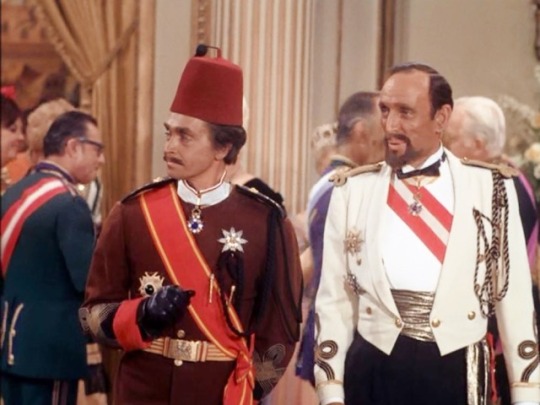
“Lucy’s Impossible Mission” (1968) ~ In this parody of “Mission: Impossible” (a Desilu / Paramount production), Lucy Carter fights international espionage in the persons of Mulhill Omar (Tim Herbert) and Ambassador Korlik of the Slobtoni Embassy (Joseph Ruskin).

“Guess Who Owes Lucy $23.50?” (1968) ~ It’s Van Johnson! Or is it? Lucy loans the film star money to fix his car – but the man turns out to be a con-man posing as Johnson.
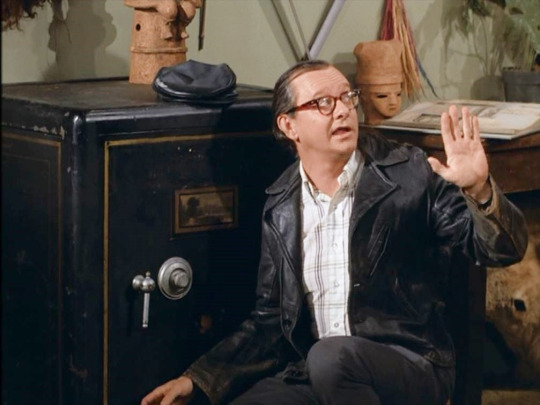
“Lucy and the Ex-Con” (1969) ~ The Unique Employment Agency sends Rocky (Wally Cox), a reformed safe cracker, on an assignment as a janitor. When the place is robbed, Rocky is the number one suspect. Disguised as old ladies, Lucy and Rocky go undercover to catch the real crook...

...Doc Morgan (Bruce Gordon). Morgan is nicknamed Doc because he uses a stethoscope when safe cracking. Bruce Gordon had played mobster Frank Nitti on Desilu’s “The Untouchables” (1959-63).
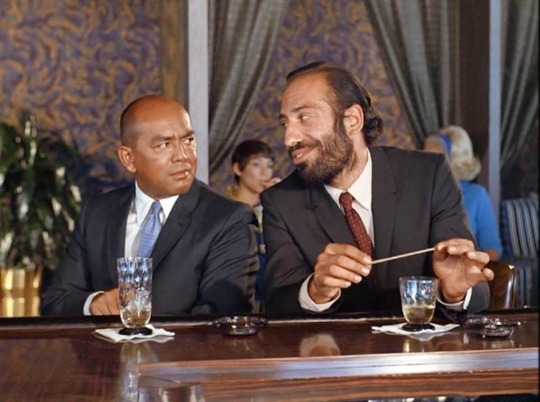
“Lucy and the Great Airport Chase” (1969) ~ Filmed on location at Los Angeles International Airport, Lucy and Harry elude dangerous spies Enemy Agent Yang (Larry Duran) and Enemy Agent Kurt (Sid Haig).
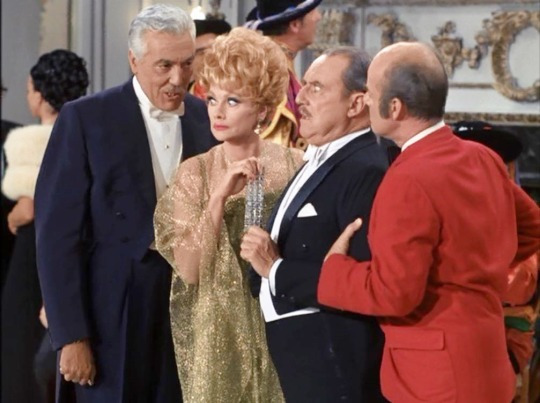
“A Date for Lucy” (1969) ~ Caesar Romero plays jewel thief Tony Rivera, Lucy’s date for a soiree at which he plans to steal the gems of a wealthy dowager. After Rivera is knocked out cold, Lady Warren (Barbara Morrison) discovers she’s been robbed. When Lucy tells her who it was, she can’t believe it.
“He’s so charming! He’s so handsome! He looks just like Cesar Romero!”

“Lucy Gets Her Man” (1969) ~ Harry’s old Army buddy is working in Counter-Intelligence and needs a stenographer to help get the goods on suspected spy Arthur Vermillion (Victor Buono). Naturally, Lucy gets the assignment. Isabel (Mary Wickes) calls Harry Jack the Ripper, comparing him to the famous London serial killer.

Lucille Ball and Victor Buono were both featured in “Like Hep!”, a Dinah Shore special that aired a few months after this episode. In it, Ball did a variety of sketches, including one set in a speakeasy with Buono as a mob boss. On television, Buono is probably best remembered for playing King Tut, one of the arch villains on “Batman” (1966-68).

“Lucy’s Burglar Alarm” (1969) ~ When Lucy and the kids are robbed and Harry refuses to fund a $500 burglar alarm, Craig comes up with an elaborate home alarm system. Guy Marks plays the well-dressed crook.
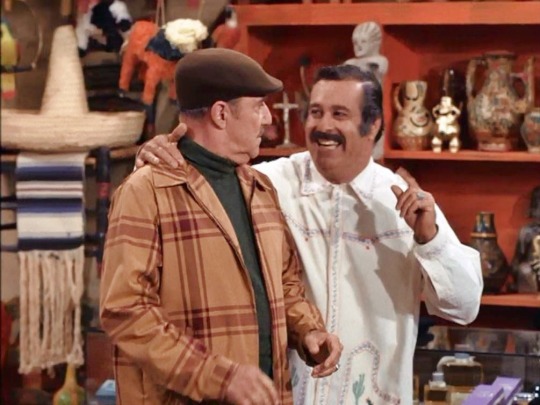
“Lucy and Viv Visit Tijuana” (1970) ~ On a sightseeing trip to Mexico, Harry is convinced by shopkeeper / smuggler Pedro (Don Diamond) to transport a stuffed animal over the border, claiming it is for his 3 year-old niece living in Los Angeles. Stopped at the border, they discover it actually contains contraband.
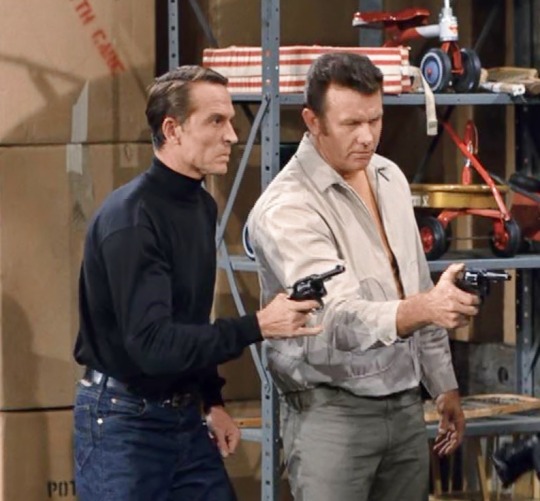
“Lucy and Wally Cox” (1970) ~ Lucy and Wally are assigned to be security guards at a warehouse, where they encounter armed robbers Lefty Logan (X Brands) and Baby Face Johnson (Gil Perkins).

“Lucy and Ma Parker” (1970) ~ When a woman and two children mysteriously move in next door, Lucy discovers that they're a band of criminals led by Ma Parker (Carole Cook). Her cohorts are little people dressed as archetypal children: Herman Golub (Billy Curtis) is dressed as Buster Brown, and Milton / Mildred (Jerry Maren) is dressed as Shirley Temple.

Lucy is recruited to impersonate Ma Parker and help nab dangerous Chicago mobsters Muggsy (Boyd ‘Red’ Morgan) and Joe Grapefruit (Marc Lawrence).
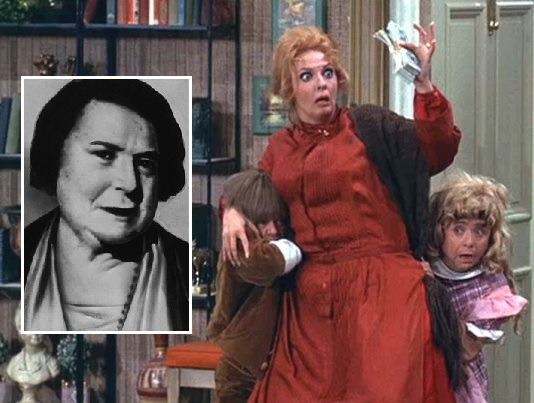
The title character is a parody of Kate 'Ma' Barker (inset), the mother of several criminals who ran the Barker gang in the 1930s. She traveled with her sons during their criminal careers.

“Lucy and Harry’s Italian Bombshell” (1971) ~ When Lucy and Kim sleep at the office, they encounter a burglar (Herbie Faye). Instead of robbing them, the he actually gives Kim and Lucy five dollars!
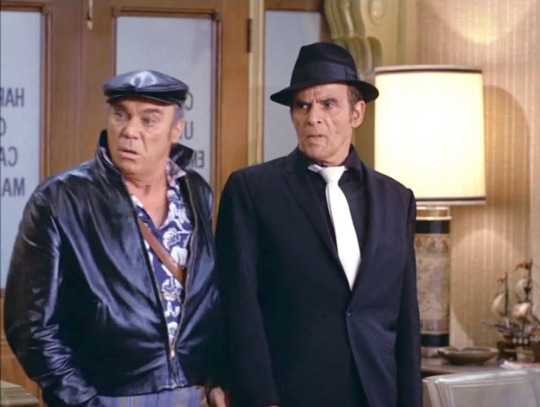
“Lucy and Mannix are Held Hostage” (1971) ~ Mannix (Mike Connors) and Lucy are taken hostage by Vernon (John Doucette) and Ruby (Marc Lawrence).
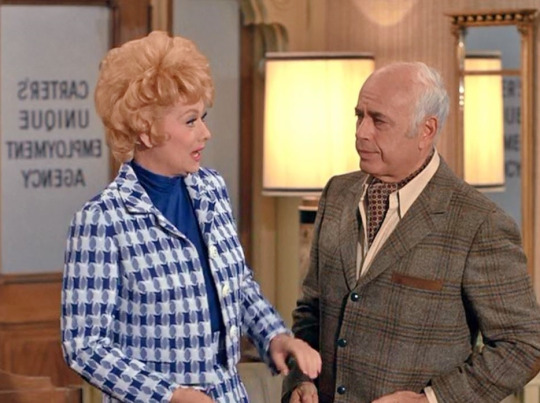
“Lucy and the Candid Camera” (1971) ~ Allen Funt, host of TV’s “Candid Camera”, plays himself and his con-man doppelganger.

As the con-man, he convinces the Carters to rob a fur salon, then a bank - all under the impression they are pranks for the TV show.
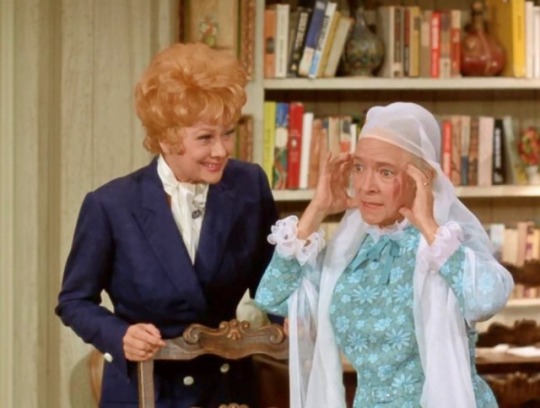
“Lucy and the Little Old Lady” (1971) ~ When Mrs. Brady, a kindly widow from out of town (Helen Hayes), comes to the Unique Employment Agency looking for a part-time job, Kim becomes suspicious that she may be running a con game so they plan to hold a fake séance to expose her. The character Hayes plays here capitalizes on her Oscar-winning role of Ada Quonsett in Airport (1970), a sweet little old lady who cons the airlines and stows away to get free air travel. On “Here’s Lucy” the plot relies on the premise that Mrs. Brady could be a con artist.

“Lucy and the Reckless Wheelchair Driver” (1972) ~ Hickey, a show business agent (Jesse White), tries to sue Lucy for hitting his client with her wheelchair. Lucy and Harry think the young man is faking and that the agent is a con artist.

“Dirty Gertie” (1972) ~ In this story based on A Pocketful of Miracles, Lucy is mistaken for an apple peddler who just happens to be the good luck charm of Rocky (Bruce Gordon), a mob boss. The police recruit Lucy to help capture the mobster in his own nightclub. Johnny Silver plays Benny, one of Rocky’s mob.

Other mobsters include ‘Moose’ Murdock (John Harmon) and ‘Numbers’ Smith (Ed Hall).
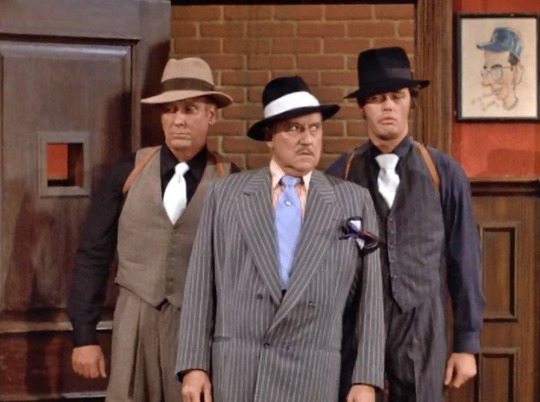
“My Fair Buzzi” (1972) ~ Kim’s shy and awkward friend Annie Whipple (Ruth Buzzi) comes out of her shell in order to audition for a 1920s revue in which Harry plays a mobster named ‘Big Jake’.
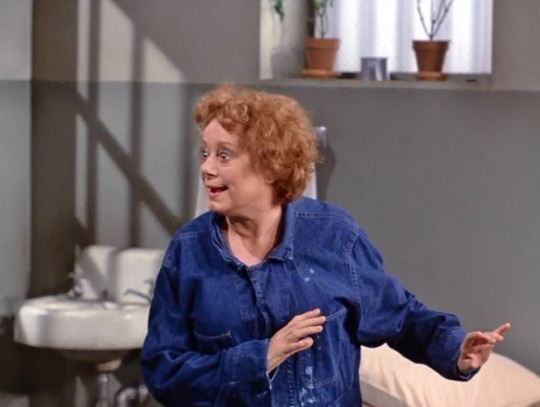
“Lucy Goes To Prison” (1973) ~ Lucy goes undercover as a convict to get information out of bank robber Mumsie Westcott (Elsa Lanchester).

“Lucy Plays Cops and Robbers” (1973) ~ Lucy forms a neighborhood watch group and starts seeing criminals where there are none. After several false alarms to the local police, a real burglar (Gino Conforti) actually shows up!

“Lucy the Sheriff” (1974) ~ Lucy finds out that her grandmother was the first woman sheriff of a Montana town that is celebrating its centennial. She is asked to play her grandmother at the celebrations, which include the recreation of a bank robbery. Lucy is enjoying playing lawmaker until Jake (Cliff Osmond) and Rusty (John Craig), a couple of genuine robbers, interrupt the celebration and take her hostage!
#Lucille Ball#Here's Lucy#TV#CBS#Gale Gordon#Gangsters#Gino Conforti#Jesse White#Elsa Lanchester#Helen Hayes#Allen Funt#Wally Cox#Bruce Gordon#Van Johnson#Cesar Romero#Lucie Arnaz#Desi Arnaz Jr.#Carole Cook#Jerry Maren#Ma Barker
3 notes
·
View notes
Photo
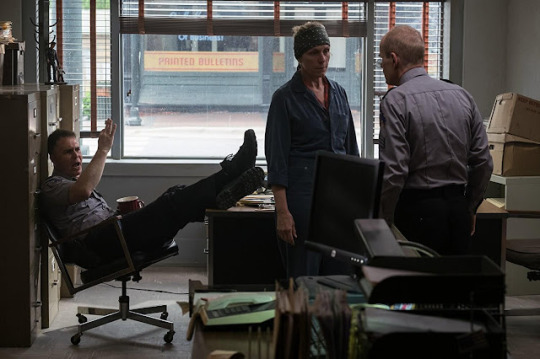
Sam Rockwell, Frances McDormand, and Zeljko Ivanek in Three Billboards Outside Ebbing, Missouri (Martin McDonagh, 2017)
Cast: Frances McDormand, Woody Harrelson, Sam Rockwell, Abbie Cornish, Lucas Hedges, Zeljko Ivanek, Caleb Landry Jones, Clarke Peters, John Hawkes, Peter Dinklage, Sandy Martin. Screenplay: Martin McDonagh. Cinematography: Ben Davis. Production design: Inbal Weinberg. Film editing: Jon Gregory. Music: Carter Burwell.
Frances McDormand and Sam Rockwell got the Oscars they deserved: Mildred Hayes's sour persistence and Jason Dixon's stupidity make them just short of caricatures; they needed the nuances provided by McDormand and Rockwell to come to any semblance of life. But the performer who gives Martin McDonagh's Three Billboards Outside Ebbing, Missouri the grounding it needs is Woody Harrelson, one of those actors, like John Goodman or the late Bill Paxton, whose presence in the cast could make any movie just a little bit better. Chief Willoughby, the butt of Mildred's billboards, is not the dumb small-town police chief that we (and of course Mildred) first believe him to be. He's a more complex figure, who even achieves a measure of tragic grandeur with his suicide, carefully leaving a note on the hood he puts over his face to tell his wife not to remove it but to leave that to the police, and then leaving behind notes for his nemesis, Mildred, and for Dixon ("I'm dead now, sorry about that") that set the remainder of the film in motion. He gives McDonagh's acerbic screenplay a bit of warmth, though maybe not enough: I found Three Billboards a less satisfying film than his wonderful In Bruges (2008). But like that film, it has a fascinating texture provided by a supporting cast full of skillful players: Lucas Hedges as Mildred's somewhat exasperated son; Zeljko Ivanek as the desk sergeant trying to bring order out of the office chaos ("You do not allow a member of the public to call you a fuckhead in the station house"); Caleb Landry Jones as the advertising manager who gets the brunt of the town's protests and is tossed out of a window by Dixon; Clarke Peters as the level-headed new chief who manages to restore order after Willoughby's death; John Hawkes as Mildred's hair-trigger ex-husband encumbered with an air-headed girlfriend; Peter Dinklage as Mildred's suitor bearing up under constant reminders that he's a "midget"; and Sandy Martin as Dixon's demanding racist mother. There are also scenes that come out of nowhere, as when Mildred, tending the flowers at her billboards, carries on a tender, one-sided conversation with a deer that has wandered into the field and is watching her. In the runup to the Oscars, when it was a contender for best picture, Three Billboards encountered some criticism for not taking more seriously Dixon's treatment of Black people, especially since the real town of Ferguson is in the same state as the fictional Ebbing. There's some justice to the charge that McDonagh is being insensitive, but satire is always insensitive. It's not a great film, I think, but maybe that judgment is premature. As Mildred says, "I guess we can decide along the way."
2 notes
·
View notes
Text

Congressman Alcee Lamar Hastings (September 5, 1936 – April 6, 2021) was a politician and judge from the state of Florida.
He was born in Altamonte Springs, Florida, the son of Mildred L. (Merritt) and Julius “J. C.” Hastings. He was educated at Crooms Academy in Goldsboro (Sanford), Florida, before going on to attend Howard University and Fisk University. He earned his BA in Zoology and Botany from Fisk. After being dismissed from Howard University School of Law, he received his JD from Florida A&M University College of Law. He became a member of the Kappa Alpha Psi Fraternity. He was admitted to the bar in 1963 and began to practice law.
He was nominated to the United States District Court for the Southern District of Florida by President Jimmy Carter. He was confirmed by the Senate. In 1981, after an FBI sting operation, he was charged with conspiracy to solicit a bribe. Following a 1983 criminal trial, he was acquitted; he was impeached for bribery and perjury by the House of Representatives in 1988 and was convicted by the Senate on October 20, 1989. While he was removed from the bench, the Senate did not bar him from holding public office in the future. He was the first and only African American impeached.
A Democrat, he was first elected to the House of Representatives in 1992. He represented Florida’s 23rd congressional district from (1993-2013) and represented Florida’s 20th congressional district from 2013 until his death. The 20th district included most of the majority African American precincts in and around Fort Lauderdale and West Palm Beach. Following Senator Bill Nelson’s departure from office in January 2019, he became the dean of Florida’s congressional delegation; he retained this title until his death.
He was married three times and had three children; his first two marriages ended in divorce. He married Patricia Williams in 2019, and they remained together until his death. #africanhistory365 #africanexcellence #kappaalphapsi
0 notes
Text
Alright since cringe is dead, I'm info dropping about my OCs, idc if you don't want to know you get to now (I'm using this picrew since I haven't the time to make actual headshots for all of them)
Nova Robertson

Birthday: May 13th
Favorite Color: Jade green
Symbolism motifs: Sun, big cats (mostly lions)
Personality: Firey, passionate, stubborn, curious
Fun fact: She's very tall! Like 6'
Angela Gartner

Birthday: May 17th
Favorite Color: Bubblegum pink
Symbolism motifs: Daisies, stars
Personality: Bubbly, sensitive, selfless, sociable
Fun fact: Her house is based on a real abandoned dvd rental place that's across the street from my house
Jessica "Jez" Salucci

Birthday: November 19th
Favorite Color: Cherry red
Symbolism motifs: Trees, electric guitar
Personality: Independent, abrasive, determined, reserved
Fun Fact: She rollerblades in her free time
Millie Easton

Birthday: June 4th
Favorite Color: Lavender
Symbolism motifs: Meadows, gears
Personality: Intelligent, clumsy, creative, perfectionistic
Fun Fact: Her first name is Amelia, not Mildred
Kylar Sato

Birthday: December 2nd
Favorite Color: Charcoal grey
Symbolism motifs: Metal, maps
Personality: Bold, chaotic, direct, defiant
Fun Fact: She is so good at impressions and impersonations that it's scary
Brianna Rosa

Birthday: September 30th
Favorite Color: Goldenrod yellow
Symbolism motifs: Wheat fields, breeze
Personality: Organized, blunt, stuck-up, dedicated
Fun Fact: She's a distant relative of Catherine of Aragon
Gene Carter

Birthday: April 26th
Favorite Color: Teal
Symbolism motifs: Moon, ocean
Personality: Caution, supportive, emotionally fragile, willing to help
Fun Fact: He's a very musical guy, he knows a lot of instruments
Quill Torres Martinez
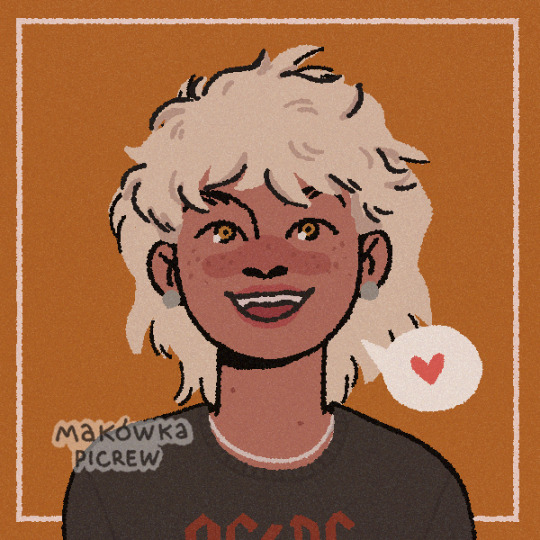
Birthday: July 6th
Favorite Color: Burnt orange
Symbolism motifs: Fire, beach
Personality: Goofy, easliy bored, charismatic, disordered
Fun Fact: His parents are very rich, he's a bit spoiled
Rae Woodfield

Birthday: February 10th
Favorite Color: Indigo
Symbolism motifs: Butterflies, rain
Personality: Impulsive, open-minded, dissatisfied, analytical (if she thinks about something first)
Fun Fact: She has port wine stain birthmarks under her eyes
Jesse Mintz

Birthday: October 29th
Favorite Color: Forest green
Symbolism motifs: Gladiolus, bricks
Personality: Quiet, calm, dependable, insecure
Fun Fact: He's naturally good at skateboarding
Benedict Lewis

It won't let me add more audio links so pretend its a link to Sparks by Coldplay
Birthday: March 27th
Favorite Color: Navy blue
Symbolism motifs: Dogs, photos
Personality: Prepared, unrealistic, altruistic, overly reminiscent
Fun Fact: He always carries a bag full of absolutely anything you could need
Thea Robertson

Again, only 10 audio links so pretend it's Gold Dust Woman by Fleetwood Mac
Birthday: May 23rd
Favorite Color: Tangerine
Symbolism motifs: Gold, sunflowers
Personality: Tense, rational, aloof, protective
Fun Fact: She's the oldest of the group, and Nova's older sister
#hiraeth#dusty writes#the songs both describe them are are songs they would listen to#but not necessarily my music taste
0 notes
Text

MILDRED CARTER and ROLANDE PELLETIER in AND THEN THE DAWN CAME (a bob fic) [coming soon]
The duo had been staring out towards the darkness for only a few hours now, at least for the better part of the early morning (way too early of a morning); they'd arrived at the designated location late last night only to find that they were desperately alone in the Normandy wilderness - now they awaited movements, signs of gunfire or even light to signal they could prepare to move locations again.
" This is my first time in Normandy." the Maquis member whispered from beside Mildred, barely moving an inch of her body, perfectly poised in textbook form, blending into the tree that stuck up from the ground beside her," This makes me hope that it is my last." A thin-lipped smirk perked up on the corner of Mildred's lips there in the darkness.
" It's my fourth." Mildred said quietly back, catching the Maquis member's peripheral vision move its way over towards her," Makes me think the war is trying to tell me something." The Maquis member's chuckle against the leaves of the tree was worthwhile.
" It is not doing good job of telling you." the Maquis member whispered back," It appears that for others, it did job well enough. For you? I am highly in doubt of such thing." Mildred felt goosebumps press against her skin as a chill ran up her spine, despite the thin layer of sweat that materialized on her forehead once she had jumped out of the transport and followed the Maquis member into the dark tree line to hide from sight.
" I think the prison sentence was enough." The Maquis member's eyes did not shy away from meeting her own as their gazes collided in the darkness, her dark brown eyes, searching Mildred's own green ones, flicking about before moving to hold her attention again. Speculating. Assessing.
" Prison sentence." the Maquis member said," You do not appear to be the type to deal with such things." Mildred almost snorted at her words and shook her head.
" I don't appear to be a lot of things now, do I?"
#band of brothers#band of brothers fic#attdc#and then the dawn came#mildred carter#rolande pelletier#HELLO#it's been a MINUTE#been pushing through college - it's been tough at the moment to do really anything not-school-related so !!!#but i think#i THINK#we have ATTDC hitting ao3 soon ! :D#which i am incredibly excited for!!!#it's been a long time coming#(cue taylor swift's maathp)#ANYWAy#plz enjoy millie and rolande in the prologue for attdc basically trying to figure the other one out without actually doing so#this prologue is just GAH I LOVE IT SM#i'm excited to post it!#ENJOY!#bob fic#bob oc#oss agent#maquis member#for those wondering: yes rolande is half french/half polish + english isn't her first language so !!!!#just so anyone who is interested is aware
10 notes
·
View notes
Text

Laura Linney and Liam Neeson in Kinsey (2004). Music was composed by Carter Burwell. Carter was born in New York City and has 111 composer credits from Blood Simple (1984) to 2023.
He has three Oscar nominations and his other notable credits include Psycho III, Raising Arizona, Millers Crossing, Barton Fink, Buffy the Vampire Slayer, This Boys Life, The Hudsucker Proxy, Rob Roy (also with Liam), Fargo, The Big Lebowski, Gods and Monsters, Velvet Goldmine, Being John Malkovich, Three Kings, Mystery Alaska, Before Night Falls, The Man Who Wasn't There, Adaptation, Intolerable Cruelty, The Ladykillers, No Country for Old Men, In Bruges, Burn After Reading, Twilight, Where the Wild Things Are, True Grit, Mildred Pierce, The Twilight Saga: Breaking Dawn - Part 1 and 2, Seven Psychopaths, Carol, Hail Caesar, The Founder, Three Billboards Outside Ebbing Missouri, The Ballad of Buster Scruggs, The Tragedy of Macbeth, 20 episodes of The Morning Show, and The Banshees of Inisherin.
Twelve of the above films are entries among my best 1,001 movies and six are honorable mentions.
2 notes
·
View notes
Text
LÉGENDES DU JAZZ
COZY COLE, LE SEUL ET UNIQUE
‘’Cozy was one of a kind. There'll never be another Cozy, that is for sure."
- Jonah Jones
Né le 17 octobre 1909 à East Orange, au New Jersey, William Randolph "Cozy" Cole avait cinq ans lorsqu’il avait commencé à jouer de la batterie. Cole était issu d’une famille de musiciens. Les trois frères de Cole étaient également musiciens de jazz. Son frère Herbie était aussi batteur.
Même s’il avait été influencé par Chick Webb, Buddy Rich, Louie Bellson, Gene Krupa et Jo Jones, Cole avait surtout été marqué par Sonny Greer.
DÉBUTS DE CARRIÈRE
Après avoir étudié durant deux ans à la Wilberforce University en Ohio, Cole s’était installé à New York où il avait commencé à être fasciné avec le jeu de Greer qui se produisait alors avec l’orchestre de Duke Ellington. Cole avait amorcé sa carrière professionnelle en 1928 avec le groupe de Wilbur Sweatman, un chef d’orchestre bien connu de Harlem.
En 1930, Cole s’était joint aux Red Hot Peppers de Jelly Roll Morton, avec qui il avait fait ses débuts sur disque dans le cadre d’une pièce qui avait été composée spécialement en son honneur: "Load of Cole", sur laquelle il avait interprété un long solo. Après avoir joué de 1931 à 1933 avec le groupe de Blanche Calloway, la soeur du célèbre chanteur et chef d’orchestre Cab Calloway, Cole avait fait partie du premier orchestre de Benny Carter (aux côtés de Teddy Wilson, Chu Berry et Dickie Wells en 1935-1936) et du groupe de Willie Bryant (1936-1938) avant de se joindre au petit groupe du violoniste Stuff Smith (1938-1939) puis à l’orchestre de Cab Calloway (1939-1942).
Grande vedette du swing, Cole s’était aussi produit avec le pianiste Teddy Wilson et accompagné les chanteuses Billie Holliday de Mildred Bailey. À l’époque, Cole avait également travaillé avec d’autres grands noms du jazz comme Henry ‘‘Red’’ Allen, Bunny Berrigan, Bud Freeman, Chu Berry et Lionel Hampton.
Poursuivant sur sa lancée à la fin des années 1930, Cole avait joué avec le Jump Band de Pete Brown, les Delta Six de Joe Marsala, Wingy Manone, Duke Ellington et les All Stars de Leonard Feather. Dans le cadre de sa collaboration avec ce dernier groupe, Cole avait notamment joué sur des pièces spécialement conçues pour mettre en évidence ses habiletés de batteur comme ‘’Ratamacue’’, ‘’Paradiddle Joe’’ et ‘‘Crescendo In Drums’’. En 1943, Cole avait aussi fait une apparition dans la revue Carmen Jones (une adaptation du célèbre opéra Carmen de Bizet) dans laquelle il avait joué en solo sur la pièce ‘’Beat Out That Rhythm On A Drum.’’ Commentant sa performance dans le cadre de la revue, Cole avait déclaré: "I think I'm the only drummer to have been featured in a big Broadway show with his name on the program."
Par la suite, Cole avait joué et enregistré avec Lionel Hampton, Coleman Hawkins, Roy Eldridge, Jonas Jones et les Louis Armstrong’s All Stars. En 1943, Cole était devenu un des premiers de musiciens de couleur à briser la frontière raciale lorsqu’il avait été recruté par le directeur musical de la radio de CBS Raymond Scott. Lors d’une entrevue accordée en 1985, Scott avait précisé: "Cozy was the most professional musician I've ever worked with." Cole avait continué de travailler pour CBS jusqu’en 1945.
En 1944, Cole avait co-dirigé un petit groupe avec Benny Goodman au club Onyx de New York.
Poursuivant parallèlement sa formation au milieu des années 1940, Cole s’était inscrit à la prestigieuse Juilliard School of Music où il avait suivi des cours de théorie, d’harmonie, de piano, de timpani et de batterie avec le réputé Saul Goodman du New York Philharmonic Orchestra. Un an plus tard, Cole avait enregistré avec Benny Goodman, Ella Fitzgerald et Louis Armstrong. En 1949, Cole s’était joint aux All Stars de Louis Armstrong avec qui il avait joué pendant quatre ans. Peu après, Cole avait ouvert la Krupa and Cole Drum School avec son ami Gene Krupa. Soulignant l’importance de l’éducation, Cole avait commenté: "The more you study, the more you find out you don't know; but the more you study, the closer you come." L’école avait remporté un grand succès et était demeurée en activité jusqu’à la mort de Krupa en 1973.
Cole et Krupa avaient aussi souvent joué en duo au club Metropole de New York dans les années 1950 et 1960. Comme professeur, Cole avait également fait des lectures à la Capital University à Columbus. Il avait aussi brièvement enseigné à la Juilliard School of Music. Parmi les étudiants de Cole, on remarquait le futur batteur Philly Joe Jones.
Plutôt inhabituel pour un batteur des années 1950, Cole avait fait deux brèves apparitions dans des films qui illustraient des styles complètement différents: ‘’The Glen Miller Story’’ en 1954 avec James Stewart, June Allyson et Gene Krupa et ‘‘Don’t Knock The Rock’’ avec Bill Haley, Little Richard et le groupe The Treniers en 1956. En 1944, Cole avait aussi joué dans le film ‘’Jammin' the Blues’’ aux côtés de Lester Young, Red Callender, Sid Catlett, Harry ‘’Sweets’’ Edison, Illinois Jacquet et Barney Kessell. Il avait également fait une apparition dans le film ‘’Make my Music’’ avec Benny Goodman.
En 1958, Cole était devenu un des premiers batteurs à atteindre la première position du Billboard avec la pièce ‘’Topsy Part 2’’ dans laquelle il avait interprété un long solo. C’était une des premières fois de l’histroire qu’un solo de batterie atteignait le sommet du palmarès Billboard. La pièce s’était également classée à la première position du palmarès R & B. Le disque, qui s’était vendu à un million d’exemplaires, était une nouvelle version d’un grand succès de Count Basie en 1937. La pièce avait été reprise par Benny Goodman en 1938. En plus de ‘’Topsy Part 2’’, le groupe de Cole, surnommé The Cozy Cole Combo, avait connu d’autres grands succès avec des pièces comme "Jersey Jump-Off", "Willow Weep For Me" et "Night Wind." Cole avait fait de nombreuses tournées avec son groupe en plus d’enregistrer à l’occasion. Comme soliste, Cole avait également participé à des tournées en Europe avec Jack Teagarden (1957) et Earl Hines.
Après avoir été engagé en 1949 par Louis Armstrong pour travailler avec ses All Stars, Cole s’était produit le 7 juin 1953 aux côtés d’Armstrong et de la chanteuse Velma Middleton dans le cadre de la 9e édition de la Cavalcade du Jazz tenue au stade Wrigley Field de Los Angeles. Produit par Leon Hefflin, le concert mettait également en vedette de grands noms du jazz comme Roy Brown and his Orchestra, Don Tosti and His Mexican Jazzmen, Earl Bostic, Nat "King" Cole ainsi que Shorty Rogers and his Orchestra. Cole participe aussi à des tournées en Europe avec le groupe en 1949 et 1952.
Après avoir quitté Armstrong en 1953, Cole avait formé son propre groupe qui avait poursuivi ses activités jusqu’en 1969. La même année, Cole avait retrouvé son vieil ami, le trompettiste Jonah Jones, avec qui il avait joué au début de sa carrière dans le cadre des groupes de Stuff Smith et de Cab Calloway. Le duo avait continué de faire des tournées et d’enregistrer dans les années 1970.
En 1959, Cole s’était aussi produit à la Peacock Alley de St. Louis avec son épouse Lee Parker, une danseuse qui avait étudié sous la direction de Katherine Durham.
DERNIÈRES ANNÉES
Reconnu pour sa versalitité, Cole était réputé pour pouvoir jouer dans n’importe quel style. Il avait même enregistré du rock n’ roll avec Eddie Fontaine. La chanson intitulée ‘’Nothin Shakin’’’ avait éventuellement été reprise par les Beatles en 1962 sur l’album Live At The Star Club. Cole avait également enregistré ses propres albums comprenant des chansons comme ‘’It’s A Rocking Thing’’, ‘’Organ Grinders’ Swing’’’ (qui avait été popularisée par l’organiste Jimmy Smith en 1965) et ‘’Whole Lotta Shakin’ Going On’’ de Jerry Lee Lewis. Loin d’être réfractaire à l’apparition du bebop contrairement à plusieurs musiciens de swing de son époque, Cole avait même enregistré avec Charlie Parker et Dizzy Gillespie en 1945.
Titulaire d’un doctorat honorifique en arts musicaux de l’Université de Columbus en 1978, Cozy Cole est mort d’un cancer le 9 janvier 1981 à Ohio State University Hospital de Columbus en Ohio. Il était âgé de soixante et onze ans. Cole s’était installé à Columbus en 1976, lorsqu’il était devenu artiste en résidence et lecteur à la Capital Universty.
Décrivant le style de Cole, le professeur de percussions de Capital University, Bob Breithaupt, avait déclaré: ‘’What he did between his hi-hat and bass drum were primarily tap dancing things. Then he’d simply play on top of it. But during the ’30s, that was pretty significant because no one was doing it. His solo techniques were really amazing. He found he could superimpose rhythms on top of one another and get some real interesting sounds. He obviously had some coordination that most people didn’t have.” Considérant Cole comme le Spinoza de l'histoire du jazz, le compositeur et multi-instrumentiste Alan Gerber l’avait décrit comme ‘’le représentant de la rigueur lumineuse et patiente, infatigable artisan d'évidences.’’
Batteur sobre et discret, Cole était avant tout un joueur d’équipe qui cherchait à mettre en valeur les autres musiciens. Grand pionnier de la batterie un peu comme Sid Catlett, Gene Krupa et Chick Webb, Cole n’avait rien d’un exhibitionniste. Comme le soulignait le violoniste André Hodeir, Cole s’appliquait surtout à ‘’créer une infrastructure propre à soutenir en toute circonstance le soliste.’’
Au cours de sa carrière, Cole avait joué avec les plus grands noms du jazz, de Teddy Wilson à Henry ‘’Red’’ Allen, en passant par Bud Freeman, Chu Berry, Bunny Berigan, Stuff Smith, Lionel Hampton, Jack Teagarden, Cab et Blanche Calloway, Jonah Jones, Roy Eldridge, Coleman Hawkins, Fats Waller, Duke Ellington, Benny Goodman, Count Basie, Don Byas, Dizzy Gillespie, Charlie Parker et Louis Armstrong.
Décrivant sa longue amitié avec Cole, le trompettiste Jonah Jones avait déclaré en 1996:
"Cozy was like my brother. He was the most wonderful person I ever met. I first met him in 1936. I was new to New York and Cozy, being from New Jersey, showed me all around. In those days Harlem was full of great musicians and I was having a difficult time, because no one knew me. But old Cozy, he saw to it that I was offered jobs. One time Teddy Wilson offered Cozy a gig to record with some new singer. Cozy told Teddy that he would only take the job if Teddy hired me. That was how nice Cozy was. When Cozy and I got down there with Teddy, we met Johnny Hodges and that young singer's name was Billie Holiday. Cozy was one of a kind. There'll never be another Cozy, that is for sure."
Plusieurs batteurs de rock avaient mentionné Cole comme une de leurs principales influences, dont le batteur Cozy Powell.
©-2024, tous droits réservés, Les Productions de l’Imaginaire historique
1 note
·
View note
Text
Round 1 Roundup!
or, one post to find them all...

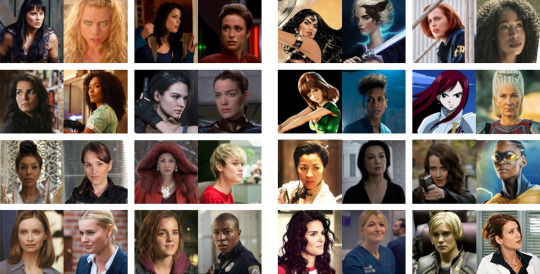


All four groups of Round 1 are now live! Find each group's masterpost with all respective links here:
Group 1
Group 2
Group 3
Group 4
Plus, all 64 individual polls are linked below the readmore.

Group 1
Sarah Jane Smith vs. Leia Organa
Deanna Troi vs. Florence (Gunpowder Milkshake)
Jody Mills vs. Andromache the Scythian
Kim Wexler vs. Villanelle
Paris Geller vs. Dr. Maura Isles
Delenn of the Religious Cast and Chosen of Dukat vs. Sister Beatrice
Lisa Cuddy vs. Seven of Nine
Ziva David vs. Michael Burnham
Una Chin-Riley (Number One) vs. Evelyn Wang
Nyota Uhura vs. Moana
Alex Danvers vs. Olivier Armstrong
Barbara Howard vs. Joan Watson
Barbara Gordon vs. Dr. Helen Magnus
B'Elanna Torres vs. Esmeralda "Granny" Weatherwax
Raelle Collar vs. Parker
Lwaxana Troi vs. Sidney Fox

Group 2
Xena vs. Bad Wolf
Lindsey Boxer vs. Anna May
Siuan Sanche vs. Jules Callaghan
Ally McBeal vs. Eve Baird
Sidney Prescott vs. Kira Nerys
Jill Valentine vs. Susan Ivanova
Chrisjen Avasarala vs. Cameron Howe
Hermione Granger vs. Henrietta Wilson
Diana Prince aka Wonder Woman vs. Susan Sto Helit
Fujiko Mine vs. Naomi Nagata
Yu Shu Lien vs. Melinda May
Jane Rizzoli vs. Dr. Bernie Wolfe
Dana Scully vs. Death of the Endless
Erza Scarlet vs. Rhaenys Targaryen
Root vs. Anissa Pierce aka Thunder
Kara Thrace vs. Dr. Addison Montgomery

Group 3
Buffy Summers vs. Jocelyn "Joss" Carter
Scarlet (Gunpowder Milkshake) vs. Modesty Blaise
Moiraine Damodred vs. Margaret Houlihan
Elizabeth Swann vs. Laris (Star Trek)
Aeryn Sun vs. River Song
Dr. Beverly Crusher vs. Kathryn Janeway
Gabrielle of Poteidaea vs. Breanna Casey
Phryne Fisher vs. Shauna Sadecki
Ava Silva vs. Miranda Priestly
Galadriel vs. Yalena "Dutch" Yardeen
Regina Mills vs. Abigail Carmichael
Sara Lance vs. Nomi Marks
Mulan vs. Hera Syndulla
Myka Bering vs. Donna Noble
Philippa Georgiou (Mirror) vs. Éowyn
Cosima Niehaus vs. Violet Baudelaire

Group 4
Jenny Calendar vs. 13th Doctor
Madeleine (Gunpowder Milkshake) vs. Helena "H.G." Wells
Camina Drummer vs. Philippa Georgiou (Prime)
Raffaela "Raffi" Musiker vs. Jane Doe
Eda Clawthorne vs. Olivia Dunham
Daisy Johnson vs. Anne Lister
Anna Mill vs. Sophie Devereaux
Dr. Temperance Brennan vs. Ahsoka Tano
Catherine Willows vs. Lara Croft
Holga Kilgore vs. Sameen Shaw
Inej Ghafa vs. Evie Frye
Jadzia Dax vs. Lena Luthor
Annabeth Chase vs. Mildred Ratched
Laura Roslin vs. Shuri
Jo Lupo vs. Samantha "Sam" Carter
Claudia Donovan vs. Willow Rosenberg
18 notes
·
View notes